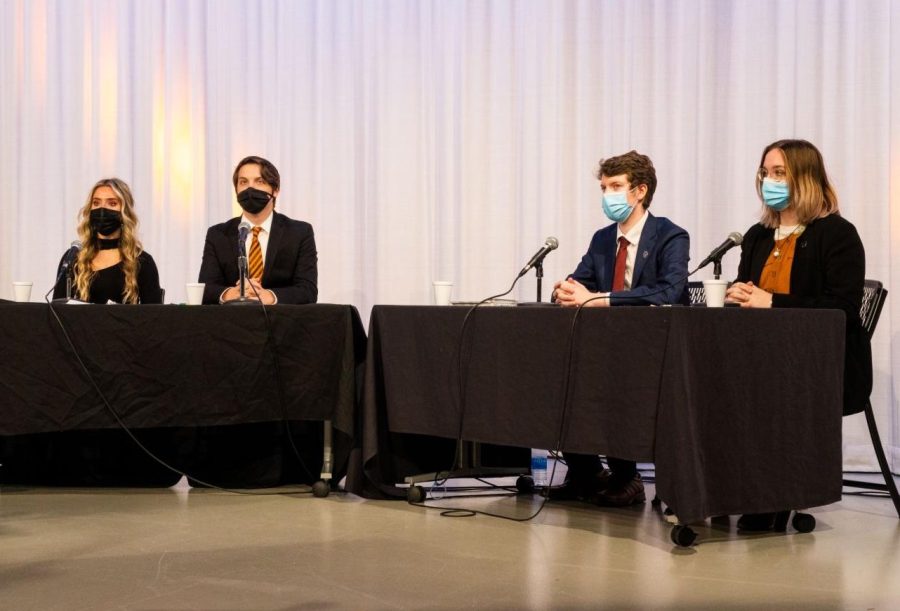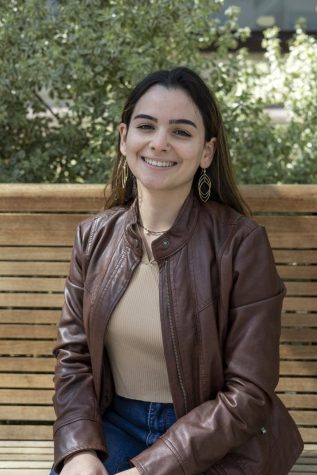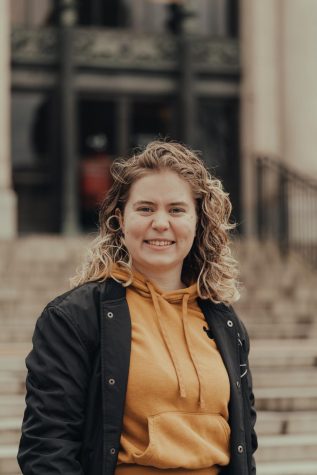ASOSU presidential candidates discuss campaign initiatives, goals during 2022 debate
February 17, 2022
Correction: A previous version of this article incorrectly stated that Kerner and Griffiths plan to host Sigma Alpha Epsilon events if elected into office. This has been corrected to Safety Awareness Events.
Four out of six presidential and vice-presidential candidates for the Associated Students of Oregon State University gathered for a debate on Feb. 16 to defend and elaborate on their platforms.
Held at the Student Experience Center, the debate was hosted by Orange Media Network and broadcast by KBVR-TV.
Presidential candidates Alexander Kerner and Matteo Paola were included in the debate alongside their respective vice-presidential candidates, Isabella Griffiths and Sierra Young. Presidential candidate Calvin Anderman and vice-presidential candidate Braeden Howard were not able to attend the debate Wednesday night.
ASOSU ballots featuring all three presidential teams as well as many other elected positions and ballot measures are currently open and will be until March 4.
The debate was moderated by The Daily Barometer Editor-in-Chief Adriana Gutierrez and Sports Chief Andres De Los Santos. The candidates tackled questions ranging from allocation of student fees, sustainability, reopening the OSU Pharmacy on campus, bridging the gap between OSU and the Corvallis community, campus security to food trucks on campus.
Both tickets began the debate by introducing themselves and their platforms.
“Some of the things Isabella and I want to do, we want to do, we want to reopen Plagmann through pharmaceutical grants, we also want to get more equipment for Dixon, we also want to further support Counseling and Psychological Services and Survivor Advocacy and Resource Center by providing more personnel, and we also want to bring food carts to campus in order to solve food diversity issues,” Kerner said.
Griffiths said she is involved in a variety of clubs at OSU and has had the opportunity to get to know the student population over the past three years, and is running for ASOSU vice president to be an advocate for those students.
“I want to be not only a friend to the students but also to be a positive advocate and bring positive changes that not only benefit and improve the lives of the students today but also the students in the future,” Griffiths said.
According to Paola, he chaired the Ways and Means Committee last year, which rewrote the student government budget and created the first piece of legislation calling for a living wage for student workers.
“Our campaign is focused on four main priorities: sustainability, seeing the OSU Foundation fully divest from fossil fuels, and renegotiating a new carbon neutrality agreement with OSU, worker rights–we want to see a living wage for all student workers and we want to see cost of living raises built into all student employment,” Paola said.
Young added that they want to focus on funding SARC and CAPS, addressing housing and food insecurity, and advancing worker rights so all student workers have a living wage.
Gutierrez’s first question was about how candidates aim to educate and increase and awareness around student fees for OSU students.
“One of the things we want to do is we really want to get more advertising out there,” Kerner said.
Kerner said he plans to implement the Rule of Seven, a marketing theory which states that if someone looks at something seven times they start to fully remember what it is.
When Kerner and Griffiths were questioned on how they would ensure all campus resources were funded in a way that is beneficial to OSU students, they discussed their plans to refill the ranks in SARC, get more people involved in SafeRide and SafeWalk and reopen the OSU Pharmacy.
“We want to try to prioritize resources that go directly to students, student health, student safety and student experience,” Kerner said.
According to Paola, he and Young would like to hear student input from all student fee funded units on the matter of student fees, perhaps through tabling at community events like the Human Services Resource Center did earlier this academic year. Paola and Young would also like to redirect fees from departments such as athletics, which receives 4% of their revenue from student fees—about $2.6 million dollars, according to Paola—towards more critical services such as the HSRC and SafeWalk program.
“Student fees go to a lot of good,” Paola said. “Especially this year, part of the reason why we’re seeing such a large increase across the board is because we got all eight student fee funded units to institute a $15 minimum wage for student workers.”
Paola recognized that the increase in fees is often paid with money from students’ bank accounts. For the future, Paola proposed requesting more funding from the OSU Foundation and lobbying at the state level for higher education funding so less money comes out of pocket from students.
Griffiths proposed that when student fees are increased, the money needs to be allocated to resources students actually use, such as CAPS, SARC and student workers. Griffiths said that students should be able to vote where the money should go.
In their rebuttal, Paola said CAPS and SARC are not currently funded by student fees due to concerns from OSU administration about not having consistent long-term funding, and because of this, Paola said they would need to fight for OSU administration to spend money on a supplementary fee for CAPS or SARC.
When Kerner and Griffiths were questioned about their plans regarding COVID-19 policies, they said they want to improve how quickly mask boxes are refilled when emptyand improve distribution of COVID-19 boosters alongside flu-shots on campus. They envision reopening the OSU Pharmacy because it would be more accessible for students who need prescriptions.
Kerner said they plan to apply for grants to reopen the pharmacy instead of using student dollars because it is complicated to ascertain how much funding they will get from student dollars, as compared to grants, which would offer a set amount of money.
Paola and Young strive to push for a hybrid model where it is required for all instructors to record lectures so students are not pressured into coming to school when they are sick. Paola said he would also like to see OSU invest in providing booster shots to all students.
“The last email that OSU administration sent out kind of reads like ‘It’s just five days, it’s not a big deal, you can miss classes,’” Paola said. “It doesn’t seem like they’re working very much with students to help them address issues that arise from them testing positive. I would like to see hybrid become mandatory for all classes.”
The candidates were also asked about how they would work with OSU Public Safety to ensure all students feel welcome and comfortable on campus.
According to Young, there needs to be a better relationship with the police force on campus.
“I think another really important thing is, as a white woman, my biggest fear is walking around in the dark, and I see a Department of Public Safety or police vehicle and it makes me feel safe,” Young said. “But I know that’s not the case for everyone and something important is to make sure we listen to those voices… I think it’s important that we reach out, before making any decisions on the police force or anything like that, to make sure we’ve heard all the voices in the room.”
Kerner said he and Griffiths want to push additional campus safety rather than police, as they have heard a lot some OSU communities are uncomfortable with the new police force.
“To increase safety awareness, we’d like to host Safety Awareness Events safety awareness events, basically in which we have tabling, we have people from campus safety… We have people talking about how to combat hate speech,” Kerner said.
Kerner and Paola both said they also wanted to increase lighting on campus.
According to Kerner, he and Griffiths want to represent the student voice on campus and represnt the OSU community on the student level.
“We’re here to represent you and to hear your wants and desires and needs and really make those changes,” Griffiths said. “We just want to make those changes for you and to represent you and to help you have the best experience at OSU that you possibly can.”
According to Paola, something that sets him and Young apart from the other tickets is the level of experience they have.
“Don’t take our word for it,” Paola said. “We have a wide variety of endorsements from people who have worked in student government, from survivor care advocates that speak not only to our campaign promises but our efforts at fighting for these things in the past, and they speak to our experience and our ability to get things done.”












































































































